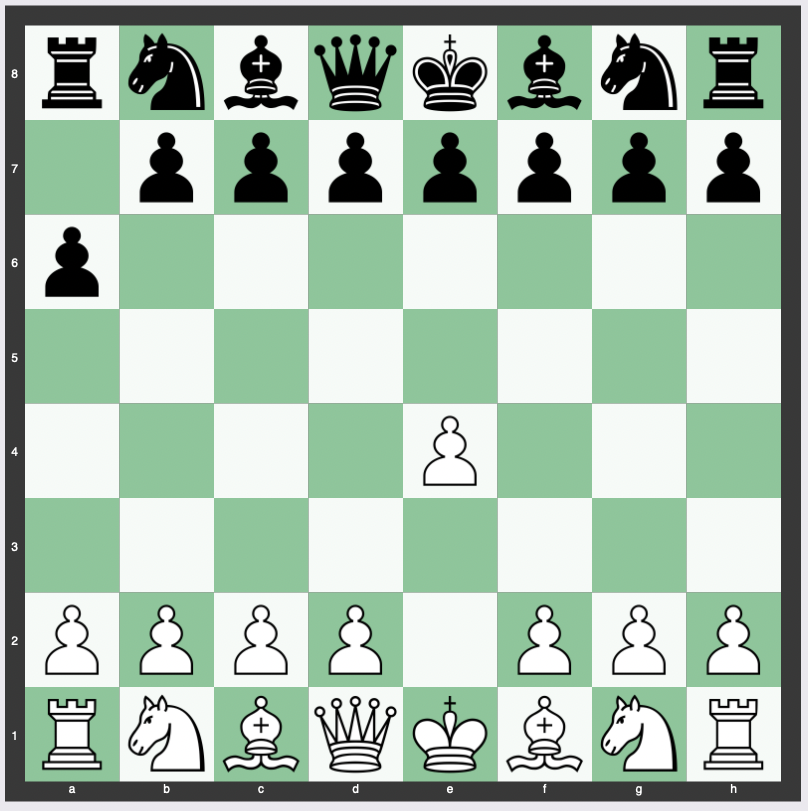The St. George Defense is a unique and somewhat unconventional opening that begins with the move 1…a6.
It’s a provocative approach, with a distinctive game plan and underlying strategy.
Here we’ll look at the St. George Defense in depth, discussing the move order, the theory and strategy behind the opening, its variations, historical significance, suitability for different skill levels, and its prevalence at the grandmaster level.
Move Order of the St. George Defense
The St. George Defense starts with the moves 1. e4 a6.

The move 1…a6 may look mysterious, but it is part of a broader strategy.
Black’s intention is to prepare a queenside advance with 2…b5.
This can prevent early bishop or knight penetration.
This opening sequence allows White to occupy the center with 2.d4.
Theory, Strategy, and Purpose of the St. George Defense
The primary purpose of 1…a6 is to prepare the move 2…b5, a queenside pawn advance.
This approach challenges traditional opening principles that emphasize control of the center.
By allowing White to establish central control, Black aims to induce overextension and create counterattacking opportunities later.
Black’s strategy may also include fianchettoing the queenside bishop and developing pieces behind the pawn structure.
Evaluation of the St. George Defense
The St. George Defense is evaluated at approximately +0.60 to +0.80, favoring a white advantage.
However, black has the advantage of not going down well-trodden theoretical paths.
Variations of the St. George Defense
There are several ways the game can continue after the initial moves, leading to different variations.
The most common White response is 2. d4, taking advantage of the opportunity to occupy the center.
White can also choose to play more cautiously with moves like 2. Nc3 or 2. Nf3.
Black’s plans can vary as well, including the immediate 2…b5 or developing pieces before launching the pawn advance.
Sample Lines in the St. George Defense
Continuation lines might include:
2. d4
2. d4 e6 3. Nf3 d5 4. Nc3 Nf6 5. e5 Nfd7 6. Ne2 c5 7. c3 Nc6 8. a3 Qb6 9. b4 cxd4 10. cxd4 f6
2. d4 e6 3. Nf3 d5 4. Nc3 Nf6 5. e5 Nfd7 6. Ne2 c5 7. c3 Nc6 8. a3 Qb6 9. b4 cxd4 10. cxd4 Be7 11. Be3 a5 12. b5 Qxb5
2. d4 e6 3. Nc3 d5 4. Nf3 Nf6 5. e5 Nfd7 6. Ne2 c5 7. c3 Nc6 8. a3 a5 9. Nf4 Qb6 10. h4 a4 11. Be2 Qb3 12. Qd3 cxd4 13. cxd4 Nb6 14. Qxb3 axb3 15. Be3
2. d4 e6 3. Nc3 d5 4. Nf3 Nf6 5. e5 Nfd7 6. Ne2 c5 7. c3 Nc6 8. a3 cxd4 9. cxd4 Qa5+ 10. Nc3 f6 11. exf6 Nxf6 12. Bd3 Qc7 13. O-O Bd6 14. Bg5 O-O 15. Bc2 Bd7 16. Qd3 g6
2. Nf3
2. Nf3 c5 3. c4 e6 4. Nc3 Nc6 5. d4 cxd4 6. Nxd4 Qc7 7. Be3 Bb4 8. Qb3 Rb8 9. Nc2 Ba5 10. Be2 d6 11. Rc1 Nf6 12. O-O
2. Nf3 c5 3. c3 d5 4. exd5 Nf6 5. d4 Qxd5 6. Be3 cxd4 7. cxd4 Qd8 8. Nc3 e6 9. Bd3 Bd6 10. Rc1 Nc6 11. O-O
2. Nf3 c5 3. c4 e6 4. Nc3 Nc6 5. d4 cxd4 6. Nxd4 Qc7 7. Be2 Nf6 8. O-O Bb4 9. Bg5 h6 10. Bxf6 gxf6 11. Qd2 Bd6 12. g3 Nxd4 13. Qxd4 Be5 14. Qd2
2. Nf3 c5 3. c4 e6 4. Nc3 Qc7 5. Be2 b6 6. O-O Nc6 7. d4 cxd4 8. Nxd4 Bb7 9. Be3 Nf6 10. a3 Nxd4 11. Qxd4 Bc5 12. Qd3
History of the St. George Defense
The St. George Defense has been known for many years, but it gained significant attention after a particular historical moment.
Grandmaster Tony Miles famously used it to defeat World Champion Anatoly Karpov in 1980.
This victory sparked interest in the opening, and it has been employed by various players since then.
Is the St. George Defense Good for Beginners or Intermediates?
The St. George Defense is an unorthodox opening that may not be suitable for complete beginners.
It goes against many fundamental opening principles, making it more challenging for those not familiar with complex strategic ideas.
However, for intermediate players looking to experiment with unconventional strategies, it can be an exciting and rewarding choice.
How Often Is the St. George Defense Played at the Grandmaster Level?
Though the St. George Defense gained fame after Miles’ victory over Karpov, it remains relatively rare at the grandmaster level.
It is occasionally seen as a surprise weapon, but it’s not considered a mainline opening.
Its rarity at the highest level reflects its unconventional nature and the fact that it allows White significant central control.
Conclusion
The St. George Defense, beginning with 1. e4 a6, is an intriguing and unorthodox opening that offers a unique approach to the game of chess.
Though rarely seen at the grandmaster level and challenging for beginners, it provides intermediate players with an opportunity to explore unconventional strategies.
The St. George Defense’s history, variations, and underlying theory all contribute to its fascinating character and its lasting place in the diverse landscape of chess openings.
Whether or not it becomes a part of your own repertoire, understanding the St. George Defense offers insight into the rich complexity and endless possibilities of chess.
Related


